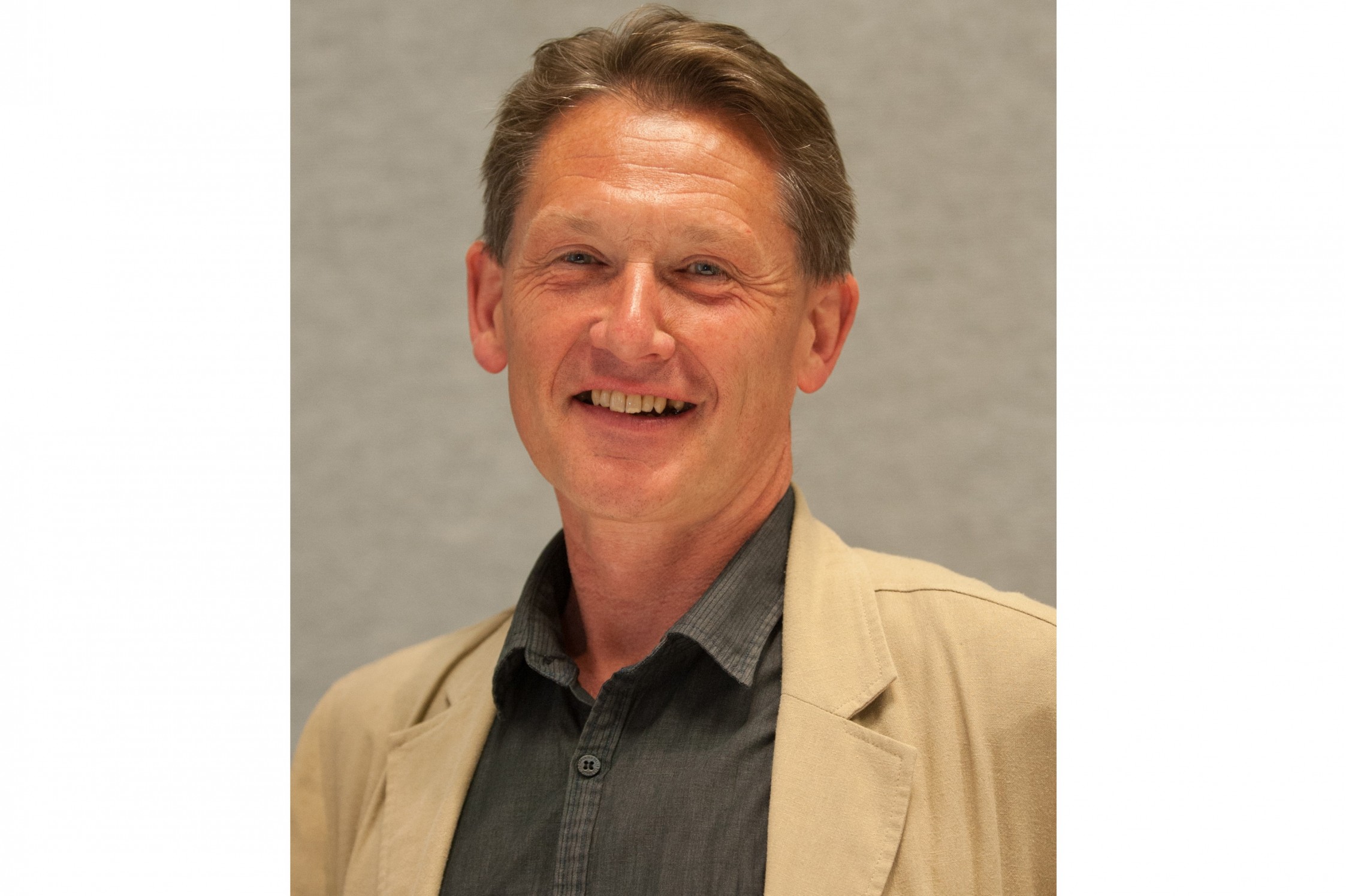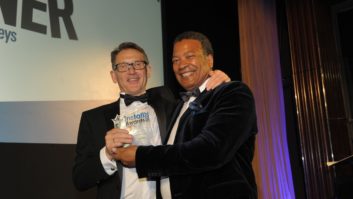
A self-taught engineer who rose to be the first president of InfoComm from outside North America, Greg Jeffreys talks to Paddy Baker about serving the association, the changing landscape for rear-projection and why ISE is going to be a little different this year.
What was your entry point into the AV industry?
A complete accident. I trained as a musician and did that for a couple of years unsuccessfully, but when marriage and responsibilities kicked in I had to start earning some money. I did part-time work for, and then joined, an exhibition company that also had a rear-projection product – using slide projectors – and I learned my trade through that. I’m completely self-taught – and it all developed like that. My life’s been a terrible mistake!
Do you think it would be difficult for someone starting out today to follow a similar career path?
I think it would be possible. It would be harder – but then it’s harder for young people to make a start in life anyway. But I really wouldn’t recommend it. The AV industry offers a tremendous opportunity for young people, but because it isn’t quite mature enough in that respect, I think it behoves people coming in to be well qualified and to prepare themselves as well as possible by what they do in college, on a degree course or on work experience.
The industry has changed so much. In the early days of boardroom projects there were all these companies, most of which have disappeared now, that were doing control systems in their own way and making it up as they went along. These resources were hardly ever used – maybe for watching Wimbledon, or the occasional meeting. But AV is now so much part of the daily business process, and the contracts are massive: a lot of the significant AV contracts are seven- or eight-figure sums, and that means are only around seven companies in the UK that can handle business on that scale. In that sense it’s become more formalised. But yet, there are other opportunities for AV in a smaller, more creative way, in areas such as retail, museums and leisure, where maybe there are opportunities to come into the industry in the way I did.
When did you start getting involved with InfoComm?
It was more than 10 years ago. At that point it was very much a US organisation, but a good friend of mine, Brian Pipe – at the time he ran a company called Video Power, but now works as a senior consultant for Arup in Qatar – was a one-man vanguard for InfoComm in the UK. Two things got me into the association. One was that I became chair of the European Council when Brian stepped down, which gave me a place on the Board of Governors. At the time, InfoComm had a number of Councils, and the chair of each of these got to be on the Board of Governors. The other aspect was that I did academic work – I wrote a degree module for UMIST (now the University of Manchester) on projected images and I also put together a task group to draw up a quality standard for projected images, and some best practice work. So that drew me to the attention of InfoComm as well.
And that culminated in you becoming the first foreign president of InfoComm.
Yes, all the other presidents had come from North America before then. At the end of 2008 a new governance structure came in – it moved to a small professional board of 12 members. There are four officers and eight directors-at-large, four of whom ended up being elected and four appointed. I was appointed for one year to be a director-at-large, and I thought that would be the end of it, but during that year I got nominated to be secretary-treasurer.
InfoComm’s governance system works really well. Being president is effectively a four-year gig. In the first year you are secretary-treasurer: you have to approve all payments above a certain sum and get down and dirty and understand how the organisation works – that’s a pretty full-on year. In the second year you’re president-elect, and in the third you’re president. In the fourth year they use you as – allegedly – a wise old bird and you chair what is now called the Leadership Search Committee, which makes significant leadership appointments and chooses the slate for those appointments that have to be elected.
So the structure has some continuity built in to it.
Yes – and frankly, if you’re not ready to be president at the start of the third year, you’ll never be ready. We’ve tried to make it so that incoming board members get to grips with it as quickly as possible, but it does take time. In my year as president – and every other president I’ve spoken to has said the same – when you get to the end of it you think, ‘I can do this now, let’s start again’ – but you’re burned out, and your year has come and gone. Also, in a lot of organisations it’s very difficult to avoid the trap of it being run by a bunch of ‘good old boys’ – the fact that you get unceremoniously booted off at the end of your service is actually really healthy.
How do you look back on your time as president?
I look on it – in the context of being on the main board for five years in total – as being my highest professional achievement. To work with people who are smarter than me, more successful than me, it makes you raise your game. It was a unique opportunity: although I try to run my businesses in a democratic way, really it’s a benign dictatorship; but with InfoComm there was a common purpose, there were no competition issues, it was very successful both financially and operationally, and we had the chance to do good things. It was just a very inspiring experience.
I also look back and think, ‘How the hell did I do it?’ as I was effectively doing four jobs at the time: I was president of InfoComm, CEO of Paradigm, CEO of Simulation Displays and also moderating a task group writing an ANSI standard. I still haven’t got an answer to that.
How has the field of rear-projection developed during the lifetime of Paradigm?
Paradigm originally existed as a general AV company when it was started in the late 1980s, but in the early 1990s we reformed it as a specialist rear-projection company, and from that into a specialist manufacturer and distributor. In those days when projectors were so dim – 200 ANSI lumens from a CRT projector was regarded as stonkingly bright – that to get a large image bright enough to be seen in a boardroom, by and large you had to do rear-projection. So the rear-projection market was a significant part of the business, and in those days it was all about winning market share – which we got thanks to the combination of our expertise in optical design, the fact that we made modular mirror systems that the dealers could install themselves, and the huge success we had with dnp rear-projection screens.
As projectors got brighter and flatpanel technologies came in, we knew that rear-projection was going to go away as a significant source of corporate revenue, and so we moved into interactivity, and dnp came out with Supernova technology, which allows front-projection to be used in high ambient light. What’s happened with rear-projection is that it’s become more specialist: it’s used mostly for signage, for large displays in corporates above 80 or 90 inches, it’s used in the leisure industry, and it’s used a lot in the simulation industry – which is partly the reason why we span out our simulation business from the main business. But in fact, rear-projection is coming back – we’re seeing a significant uptick. In the ANSI standard that applies to projected image quality, a lot of the higher levels can only be achieved with rear-projection.
ISE is approaching – you must be an ISE veteran…
Yes – in one form or another I’ve been an exhibitor every year since it started in Geneva, until this year. I was on the board of ISE until the end of 2012 and I still sit on the advisory board, so I have a very strong connection and affection for ISE. What Mike Blackman has achieved with that show, in my view, is one of the major achievements in the AV industry. To see ISE go above and beyond the US InfoComm show – and it’s still accelerating – is the most fantastic achievement. Mike has led a really great team of people and has helped them all to be really successful. I just love the show to bits.
I’m really looking forward to the show this year because for the first time I’m not exhibiting, I’m not on the InfoComm board, I’m not on the ISE board, I’m not teaching – I’m going to go and do some business!
Do you have any ISE survival tips?
There’s one tip that’s completely useless, because no-one observes it: you shouldn’t drink! No, my tip is to take more time than you think you need. Have a very structured calendar with good space between the slots. It’s such a compressed event, it’s quite hard to move around, and the halls have the most random pattern which gets worse every year. I tend to book my meetings on the hour, and try to finish them after 30 or 40 minutes. But the trouble is I walk from one hall to another and see someone I haven’t seen for yonks… it’s so hard to move around. But it’s a great thing.







